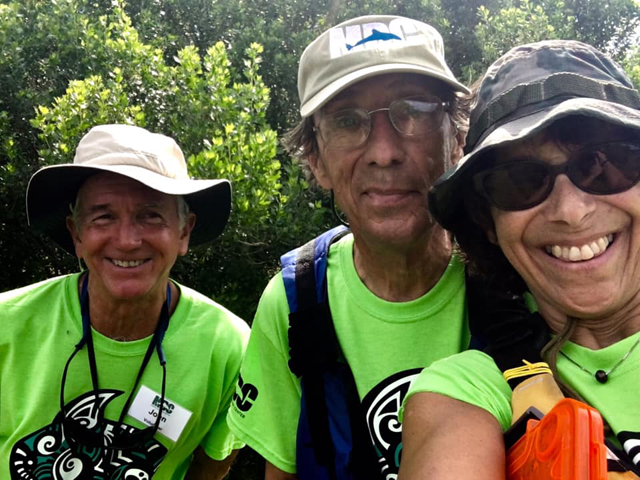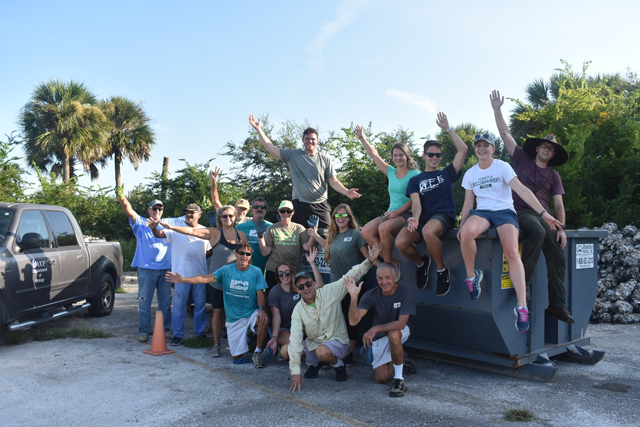Youthful beyond his years, Marine Discovery Center volunteer John Bromley is quick to raise his hand to help wherever help is needed.
If the kayak team needs help, John is there to serve as a kayak sweep. If there is a need for Brazilian pepper eradication or shoreline restoration or oyster bagging, the lithe native Floridian is Johnny-on-the-spot.
But beyond his gentle, self-effacing nature is a man who spent his 30-year career working as a nuclear chemist for Florida Power & Light in Miami. Read about him in our February Volunteer Spotlight with MDC staff writer Lisa Mickey:
Q: Where did you grow up? A: I grew up in Sarasota and graduated from high school there in 1971. After that, I went to Miami Dade Junior College and then I went to Florida State University, where I got a degree in 1978 in microbiology and chemistry. While at FSU, I participated in the cooperative education program working for NOAA (National Oceanic and Atmospheric Administration) and I also volunteered at the Smithsonian Museum of Natural History.
Q: Talk about what you did in your career. A: After I graduated, I worked at Everglades National Park and then I went to work for Weyerhaeuser in Miami, just down by the Florida Keys. I worked in their aquaculture division, where we started a pilot project to raise freshwater prawns. We were getting ready to go to Brazil, but then the project was shut down because shortly after they started the program, the timber industry hit hard times. The company had to make cuts.
Q: What happened after that? A: That’s when I went back to school at the University of Florida for agricultural engineering. I ended up working for UF in Gainesville. I worked for the department of microbiology and cell science with the Florida Sea Grant program. In the lab, we were trying to develop methane gas from sargassum. Our job was to identify the best bacteria to incubate and produce that methane gas in the decomposition of the sargassum. We published three academic papers and that research went on for three years, but it operated on a grant. When the grant ran out, I was out of a job. So I went to work for the University of Miami in their department of microbiology at the medical school. That was in the 1980s when AIDS epidemic was starting, so we were trying to isolate the AIDS virus and sequence it out in the lab. That was another grant program, so when it ran out, I went to work at Florida Power & Light in 1986 as a nuclear chemistry technician. Basically, I was just boiling water for a living and making sure the kettle didn’t blow.
Q: That’s a big jump from a medical school lab to a nuclear power plant. A: Yes, so they sent me to power school at General Physics Corporation, which was based in St. Petersburg back then. That was my introduction to nuclear power training. After that, I went to the Institute of Nuclear Power Operations, a qualifying organization for the entire nuclear power industry. As a chemist there, I had to log 80 hours a year of continuing education. We don’t want to mistakes and we certainly don’t want accidents. Humans make mistakes, but we try to minimize them and learn from them. I like to think it’s more than luck that we haven’t had serious accidents in this country. I like to think it’s more about the attitude of the organization, the companies out there, and the regulatory agencies making sure that we’re doing what the law requires us to do.
Q: How did your job change at FP&L over three decades? A: I started as a nuclear chemist technician and became a project manager for refueling outage services. That involved steam generator maintenance and things like that. Later, I worked as a nuclear chemistry instructor. I taught operators and I taught the mechanical maintenance people chemistry.
Q: Very few people in this state can say they went to Florida State, the University of Florida and the University of Miami. A: I like them all. I paid to go to Florida State and got paid to go to the other two. And now I’ve worked on the oyster restoration deployments with the University of Central Florida.
Q: While you were working in Miami, you and Loretta completely lost your home in Homestead, Fla., when Hurricane Andrew swept through south Florida in 1992 as a Category 5 storm. What did you learn about the power of nature after something like that? A: We learned to be better prepared. We didn’t even have storm shutters back then, mainly because we hadn’t had a major hurricane in 20 years or more. I was at work when the storm hit and Loretta was at home with 10 other people. It started flooding inside our house and water was blowing in the front door, which faced east – where the storm was coming from. We were without power for 41 days. It was a real eye opener. Since then, it seems that we’re experiencing more hurricanes and storms that are stronger. I also learned I didn’t want to live in Miami anymore because you’re way down there when a big storm hits.
Q: When did you and your wife Loretta move to New Smyrna Beach and when did you get involved at MDC? A: We moved here to New Smyrna Beach fulltime in June 2016 and that’s when we started getting involved with different organizations. We explored the website and took some of the kayak and boat tours. I grew up on the Gulf, so we knew we wanted to be on the water when we retired, but Sarasota is too big. Loretta had a friend who told us to check out New Smyrna. We drove over the South Causeway Bridge and the rest is history. We really liked that they didn’t allow franchise restaurants on the island. We actually bought a house here before I retired back in 2008 just as the real estate industry crashed, so when I stopped working, we moved here to stay. Loretta also retired. She had worked for the FAA (Federal Aviation Administration) as an environmental technician, maintaining all of the support units, landing lights and generators at Miami International Airport. She also worked at airports in Key West, Homestead, Miami Opa Locka, Fort Lauderdale – just wherever they had issues. She would help guide the project engineers when they came to solve problems.
Q: How did you start volunteering at MDC? A: We saw an article in the newspaper about MDC and we came over to check it out. We started talking to people and exploring the website and decided this was a place we could help out. When you retire, it just means you stop doing one thing, but you have to find something else to do.
Q: What was your first job as an MDC volunteer? A: I started in the oyster program and then I started helping with kayaks at Lagoonacy last year.
Q: And you are still doing both?
A: Yes, kayaks and the oyster program. We transported about 600 bags of oyster shells from MDC to Canaveral in late January. I’m especially happy to be able to help with some of our big kayak groups. When you have 10 guests, one guide just cannot do everything, so volunteers really help. I’ve also helped clean up Discovery Island with the shoreline [enhancements].
Q: Do you volunteer anywhere else? A: Yes, I’ve gotten involved with Oceans of Hope, another nonprofit. We have an adaptive kayak and surfing program. It provides an outlet for adaptive water programs. As a volunteer, I help get these folks in a kayak or on a surfboard to have an experience on the water. We had a surfing event last year and 150 volunteers showed up. We had five teams with 10-15 participants per team on the water. I’ve been involved with the Wounded Warriors through Oceans of Hope and we hold one surf event for them each year. We’ve also started working with Brooks Rehabilitation Hospital out of Jacksonville. They have had an adaptive kayak program for years, so we’re modeling our program after theirs.
Q: Any other volunteer work? A: I volunteer at the Surfari Club. It’s a surf club that’s been around for more than 40 years and their goal is to promote the sport of surfing. We offer scholarships for surfers coming out of high school. And then there’s the Rum Runners, which is a Jeep Club. We’ve met a lot of Wounded Warriors through that group and those folks have a lot of skills. If they want to volunteer, we’re happy to have them because we all learn together.
Q: What do you enjoy most about volunteering? A: The people I meet – the ones who work at MDC, the guests who come on the tours and other volunteers. I get a lot of reward from seeing the joy in people’s eyes. Sometimes people think physically challenged individuals are just handicapped, but they are still people with the same desires, likes and dislikes as anyone else. We really need to enable them as much as we can because they experience so much joy on the water. Life might have changed for many of these people, but their lives are not over.
Q: Do you have any hobbies? A: I enjoy fishing and diving and Loretta and I are starting to travel. We toured Italy last year. We’re going to Texas in February and I’m taking a fishing trip to Mexico in April. We want to explore while we can still get around.
Q: You ride your bike to MDC from your house whenever you volunteer. That’s a nice little workout. A: It’s only about four miles each way. I used to run, but I’ve had surgery on one knee, so now I ride my bike a lot. I try to stay active.
Q: What has been the highlight for you at MDC?
A: Just being involved in so many activities. I look forward to volunteering for the foreseeable future. As long as I’m out here volunteering, that means I’m able to get around.
Q: Is there anything else you want to try at MDC that you haven’t tried yet? A: I haven’t done water testing yet. I’d also be open to data interpretation if they should need it. I like the opportunity to try to get everybody in our community on board with the same things, such as using reusable water bottles, limiting plastics and getting rid of drinking straws. If we all do it, it can make a huge difference in the long run. We’re consuming the planet day by day and we have to think about that.
Q: What excites you the most about helping MDC with its mission in our community? A: To me, it’s all about education of the public. That’s really the strongest thing we need to do. When we make mistakes, it’s often because we don’t know any better. It’s a huge benefit for us to provide information. By doing things like holding Lagoonacy and interfacing with various community groups, it gives us a chance to share information. Sometimes when I wear my shoreline restoration T-shirt out in public, I get asked about it. It gives me a chance to talk about what we’re doing and to help spread that knowledge. If we’re going to solve our issues, I really believe we’re all going to have to work together.





Follow Us!